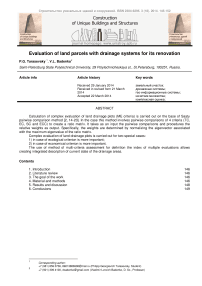Оценка земельного участка с дренажными системами для их восстановления
Автор: Тарасевский Филипп Георгиевич, Баденко Владимир Львович
Журнал: Строительство уникальных зданий и сооружений @unistroy
Рубрика: Реновация
Статья в выпуске: 3 (18), 2014 года.
Бесплатный доступ
Расчет комплексной оценки земельных участков с дренажными системами (ME критериям) осуществляется на базе Saaty метода сравнения попарно [2, 14-20]. В данном случае этот метод включает парные сравнения по 4 критериям (ТС, ЕС, SC и ECC) для создания отношения в виде матрицы. Он принимает в качестве ввода парные сравнения и относительные веса в качестве вывода. В частности, веса определяются путем нормализации собственного вектора, связанного с максимальным собственным значением коэффициента матрицы.Комплексную оценку земельных участков с дренажными системам проводят в двух частных случаях:1) экологический критерий является более важным;2) экономический критерий является более важным;Использование метода оценки по множеству критериев для определения индекса множественной оценки позволяет создавать интегрированное описание текущего состояния водосборных площадей.
Земельный участок, дренажные системы, гео-информационные системы, нечеткие множества, комплексная оценка
Короткий адрес: https://sciup.org/14322415
IDR: 14322415 | УДК: 332.28
Список литературы Оценка земельного участка с дренажными системами для их восстановления
- The State of Food Insecurity in the World. FAO. 2011. 62 p.
- Malczewski J. GIS and multicriteria decision analysis, Wiley&Sons. 1999. 392 p.
- Burrough P.A., MacMillan R.A., van Deursen W. Fuzzy classification methods for determining land suitability from soil profile observations and topography//Journal of Soil Science. 1992. №.43. Pp. 193-210.
- Badenko V.L., Latyshev N.K., Slinchuk S.G. Osobennosti geoinformacionnogo obespecheniy tehnologiy tochnogo zemledeliy [Some features of GIS-environment for precision agriculture]. Informaciya i Kosmos [Information and Cosmos]. 2009. №4. Pp. 53-58. (rus)
- Kurtener D., Badenko V. Fuzzy algorithms to support spatial planning. Chapter 14 in Geertman S. and Stillwell J. (eds.) Springer. 2003. Pp. 249-265.
- Badenko V., Kurtener D. GIS fuzzy algorithm for evaluation of attribute data quality. GIM International. 2001. №.3. Pp. 76-79.
- Rukovodstvo po opredeleniyu khimicheskogo sostava i kolichestva poverkhnostnykh i drenazhnykh vod, sbrosili irrigatsionnykh i drenazhnykh sistem v mestnosti s Nechernozem'ye polose RSFSR [Guideline on definition of chemical composition and quantity of surface and drainage waters, thrown off irrigation and drainage systems in terrain of a non-black Earth band of RSFSR]. Lengiprovodkhoz. 1989. 48 p. (rus)
- Bonham-Carter G.F., Geographic Information Systems for Geoscientists: Modelling with GIS. Elsevier Science. 1994. 398 p.
- AGROTOOL-A system for crop simulation/Poluektov R.A., Fintushal S.M., Oparina I.V., Shatskikh D.V., Terleev V.V., Zakharova E.T.//Archives of Agronomy and Soil Science. 2002. Pp. 609-635.
- Pandey A., Prasad R., Singh V. P. et al. Crop parameters estimation by fuzzy inference system using X-band scatterometer data//Advances In Space Research. 2012. № 51. Pp. 905-911.
- Li Q., Yan J. Assessing the health of agricultural land with emergy analysis and fuzzy logic in the major grain-producing region. Catena. 2012. № 99. Pp. 9-17.
- Chevalier R.F. Hoogenboom G., McClendon R.W. et al. A web-based fuzzy expert system for frost warnings in horticultural crops//Environmental Modelling & Software. 2012. № 35. Pp. 84-91.
- Sattler C., Stachow U., Berger G. Expert knowledge-based assessment of farming practices for different biotic indicators using fuzzy logic//Journal Of Environmental Management. 2011. №. 95. Pp. 132-143.
- Papadopoulos A.; Kalivas D. Hatzichristos T. Decision support system for nitrogen fertilization using fuzzy theory. Computers and Electronics In Agriculture. 2011. № 78. Pp. 130-139.
- Papageorgiou E. I., Markinos A. T., Gemtos T. A. Fuzzy cognitive map based approach for predicting yield in cotton crop production as a basis for decision support system in precision agriculture application. Applied Soft Computing. 2011. № 11. Pp. 3643-3657.
- Badenko V.L. Analiz ekologicheskikh riskov v GIS na osnove nechetkikh mnozhestv [Analysis of environmental risks in GIS based on fuzzy sets.]. Informatsiya i Kosmos [Information and Cosmos]. 2013. №3. Pp. 78-84. (rus)
- Duru N., Dokmen F., Canbay M. M. et al. Soil productivity analysis based on a fuzzy logic system//Journal Of The Science Of Food And Agriculture. 2010. No. 90. Pp. 2220-2227.
- Kurtener D., Badenko V., Yakushev V., Pourabbas E. Development of methodology of multiple assessments of landscape parcels on the base fuzzy models integrated into GIS environment. St. Petersburg Branch of International Soil Tillage Research Organisation. 1999. 14 p.
- Janssen J.A. E.B., Krol M.S., Schielen R.M.J. et al. Assessment of uncertainties in expert knowledge, illustrated in fuzzy rule-based models//Ecological Modelling. 2010. № 221. Pp. 1245-1251.
- Fischer G., Winiwarter W., Ermolieva T. et al. Integrated modeling framework for assessment and mitigation of nitrogen pollution from agriculture: Concept and case study for China//Agriculture Ecosystems & Environment. 2009. № 136. Pp. 116-124.


